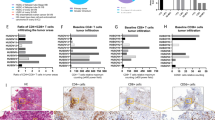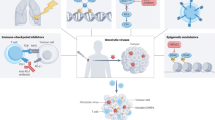Abstract
In this study, we assessed the ability of a highly tumor-selective oncolytic vaccinia virus armed with a yeast cytosine deaminase gene to infect and lyse human and murine ovarian tumors both in vitro and in vivo. The virus vvDD-CD could infect, replicate in and effectively lyse both human and mouse ovarian cancer cells in vitro. In two different treatment schedules involving either murine MOSEC or human A2780 ovarian carcinomatosis models, regional delivery of vvDD-CD selectively targeted tumor cells and ovarian tissue, effectively delaying the development of either tumor or ascites and leading to significant survival advantages. Oncolytic virotherapy using vvDD-CD in combination with the prodrug 5-fluorocytosine conferred an additional long-term survival advantage upon tumor-bearing immunocompetent mice. These findings demonstrate that a tumor-selective oncolytic vaccinia combined with gene-directed enzyme prodrug therapy is a highly effective strategy for treating advanced ovarian cancers in both syngeneic mouse and human xenograft models. Given the biological safety, tumor selectivity and oncolytic potency of this armed oncolytic virus, this dual therapy merits further investigation as a promising new treatment for metastatic ovarian cancer.
This is a preview of subscription content, access via your institution
Access options
Subscribe to this journal
Receive 12 print issues and online access
$259.00 per year
only $21.58 per issue
Buy this article
- Purchase on Springer Link
- Instant access to full article PDF
Prices may be subject to local taxes which are calculated during checkout







Similar content being viewed by others
Accession codes
References
Jemal A, Siegel R, Ward E, Murray T, Xu JQ, Thun MJ . Cancer statistics, 2007. CA Cancer J Clin 2007; 57: 43–66.
Alberts DS, Delforge A . Maximizing the delivery of intraperitoneal therapy while minimizing drug toxicity and maintaining quality of life. Semin Oncol 2006; 33 (6 Suppl 12): S8–S17.
Wenzel LB, Huang HQ, Armstrong DK, Walker JL, Cella D . Health-related quality of life during and after intraperitoneal versus intravenous chemotherapy for optimally debulked ovarian cancer: a Gynecologic Oncology Group study. J Clin Oncol 2007; 25: 437–443.
Kanerva A, Raki M, Hemminki A . Gene therapy of gynaecological diseases. Expert Opin Biol Ther 2007; 7: 1347–1361.
Davis JJ, Fang B . Oncolytic virotherapy for cancer treatment: challenges and solutions. J Gene Med 2005; 7: 1380–1389.
Parato KA, Senger D, Forsyth PA, Bell JC . Recent progress in the battle between oncolytic viruses and tumours. Nat Rev Cancer 2005; 5: 965–976.
Schepelmann S, Springer CJ . Viral vectors for gene-directed enzyme prodrug therapy. Curr Gene Ther 2006; 6: 647–670.
Liu TC, Galanis E, Kirn D . Clinical trial results with oncolytic virotherapy: a century of promise, a decade of progress. Nat Clin Pract Oncol 2007; 4: 101–117.
Khuri FR, Nemunaitis J, Ganly I, Arseneau J, Tannock IF, Romel L et al. A controlled trial of intratumoral ONYX-015, a selectively-replicating adenovirus, in combination with cisplatin and 5-fluorouracil in patients with recurrent head and neck cancer. Nat Med 2000; 6: 879–885.
Xia ZJ, Chang JH, Zhang L, Jiang WQ, Guan ZZ, Liu JW et al. Phase III randomized clinical trial of intratumoral injection of E1B gene-deleted adenovirus (H101) combined with cisplatin-based chemotherapy in treating squamous cell cancer of head and neck or esophagus. Ai Zheng 2004; 23: 1666–1670.
Freytag SO, Stricker H, Peabody J, Pegg J, Paielli D, Movsas B et al. Five-year follow-up of trial of replication-competent adenovirus-mediated suicide gene therapy for treatment of prostate cancer. Mol Ther 2007; 15: 636–642.
Coukos G, Makrigiannakis A, Kang EH, Rubin SC, Albelda SM, Molnar-Kimber KL . Oncolytic herpes simplex virus-1 lacking ICP34.5 induces p53-independent death and is efficacious against chemotherapy-resistant ovarian cancer. Clin Cancer Res 2000; 6: 3342–3353.
Bauerschmitz GJ, Lam JT, Kanerva A, Suzuki K, Nettelbeck DM, Dmitriev I et al. Treatment of ovarian cancer with a tropism modified oncolytic adenovirus. Cancer Res 2002; 62: 1266–1270.
Peng KW, TenEyck CJ, Galanis E, Kalli KR, Hartmann LC, Russell SJ . Intraperitoneal therapy of ovarian cancer using an engineered measles virus. Cancer Res 2002; 62: 4656–4662.
Hirasawa K, Nishikawa SG, Norman KL, Alain T, Kossakowska A, Lee PW . Oncolytic reovirus against ovarian and colon cancer. Cancer Res 2002; 62: 1696–1701.
Stojdl DF, Lichty BD, tenOever BR, Paterson JM, Power AT, Knowles S et al. VSV strains with defects in their ability to shutdown innate immunity are potent systemic anti-cancer agents. Cancer Cell 2003; 4: 263–275.
Tseng JC, Hurtado A, Yee H, Levin B, Boivin C, Benet M et al. Using sindbis viral vectors for specific detection and suppression of advanced ovarian cancer in animal models. Cancer Res 2004; 64: 6684–6692.
Zeh HJ, Bartlett DL . Development of a replication-selective, oncolytic poxvirus for the treatment of human cancers. Cancer Gene Ther 2002; 9: 1001–1012.
Guo ZS, Bartlett DL . Vaccinia as a vector for gene delivery. Expert Opin Biol Ther 2004; 4: 901–917.
Shen Y, Nemunaitis J . Fighting cancer with vaccinia virus: teaching new tricks to an old dog. Mol Ther 2005; 11: 180–195.
Thorne SH, Bartlett DL, Kirn DH . The use of oncolytic vaccinia viruses in the treatment of cancer: a new role for an old ally? Curr Gene Ther 2005; 5: 429–443.
Karupiah G, Coupar B, Ramshaw I, Boyle D, Blanden R, Andrew M . Vaccinia virus-mediated damage of murine ovaries and protection by virus-expressed interleukin-2. Immunol Cell Biol 1990; 68: 325–333.
Puhlmann M, Brown CK, Gnant M, Huang J, Libutti SK, Alexander HR et al. Vaccinia as a vector for tumor-directed gene therapy: biodistribution of a thymidine kinase-deleted mutant. Cancer Gene Ther 2000; 7: 66–73.
McCart JA, Mehta N, Scollard D, Reilly RM, Carrasquillo JA, Tang N et al. Oncolytic vaccinia virus expressing the human somatostatin receptor SSTR2: molecular imaging after systemic delivery using 111In-pentetreotide. Mol Ther 2004; 10: 553–561.
McCart JA, Ward JM, Lee J, Hu Y, Alexander HR, Libutti SK et al. Systemic cancer therapy with a tumor-selective vaccinia virus mutant lacking thymidine kinase and vaccinia growth factor genes. Cancer Res 2001; 61: 8751–8757.
Guo ZS, Naik A, O’Malley ME, Popovic P, DeMarco R, Hu Y et al. The enhanced tumor selectivity of an oncolytic vaccinia lacking the host range and anti-apoptosis genes SPI-1 and SPI-2. Cancer Res 2005; 65: 9991–9998.
Yang ST, Guo ZS, O’Malley ME, Yin XY, Zeh HJ, Bartlett DL . A new recombinant vaccinia with targeted deletion of three viral genes: its safety and efficacy as an oncolytic virus. Gene Ther 2007; 14: 638–647.
Naik AM, Chalikonda S, McCart JA, Xu H, Guo ZS, Langham G et al. Intravenous and isolated limb perfusion delivery of wild type and a tumor-selective replicating mutant vaccinia virus in nonhuman primates. Hum Gene Ther 2006; 17: 31–45.
Mastrangelo MJ, Maguire HC, Eisenlohr LC, Laughlin CE, Monken CE, McCue PA et al. Intratumoral recombinant GM-CSF-encoding virus as gene therapy in patients with cutaneous melanoma. Cancer Gene Ther 1999; 6: 409–422.
Kirn D, Niculescu-Duvaz I, Hallden G, Springer CJ . The emerging fields of suicide gene therapy and virotherapy. Trends Mol Med 2002; 8: S68–S73.
Niculescu-Duvaz I, Springer CJ . Introduction to the background, principles, and state of the art in suicide gene therapy. Mol Biotechnol 2005; 30: 71–88.
Bernt KM, Steinwaerder DS, Ni S, Li ZY, Roffler SR, Lieber A . Enzyme-activated prodrug therapy enhances tumor-specific replication of adenovirus vectors. Cancer Res 2002; 62: 6089–6098.
Schepelmann S, Ogilvie LM, Hedley D, Friedlos F, Martin J, Scanlon I et al. Suicide gene therapy of human colon carcinoma xenografts using an armed oncolytic adenovirus expressing carboxypeptidase G2. Cancer Res 2007; 67: 4949–4955.
Gnant M, Puhlmann M, Alexander HR, Bartlett DL . Systemic administration of a recombinant vaccinia virus expressing the cytosine deaminase gene and subsequent treatment with 5-flurocytosine leads to tumor-specific gene expression and prolongation of survival in mice. Cancer Res 1999; 59: 3396–3403.
Puhlmann M, Gnant M, Brown CK, Alexander HR, Bartlett DL . Thymidine kinase-deleted vaccinia virus expressing purine nucleoside phosphorylase as a vector for tumor-directed gene therapy. Hum Gene Ther 1999; 10: 649–657.
McCart JA, Puhlmann M, Lee J, Hu Y, Libutti SK, Alexander HR et al. Complex interactions between the replicating oncolytic effect and the enzyme/prodrug effect of vaccinia-mediated tumor regression. Gene Ther 2000; 7: 1217–1223.
Kievit E, Bershad E, Ng E, Sethna P, Dev I, Lawrence TS et al. Superiority of yeast over bacterial cytosine deaminase for enzyme/prodrug gene therapy in colon cancer xenografts. Cancer Res 1999; 59: 1417–1421.
Roby KF, Taylor CC, Sweetwood JP, Cheng Y, Pace JL, Tawfik O et al. Development of a syngeneic mouse model for events related to ovarian cancer. Carcinogenesis 2000; 21: 585–591.
Erbs P, Exinger F, Jund R . Characterization of the Saccharomyces cerevisiae FCY1 gene encoding cytosine deaminase and its homologue FCA1 of Candida albicans. Curr Genet 1997; 31: 1–6.
Chakrabarti S, Sisler JR, Moss B . Compact, synthetic, vaccinia virus early/late promoter for protein expression. BioTechniques 1997; 23: 1094–1097.
Hirschowitz EA, Ohwada A, Pascal WR, Russi TJ, Crystal RG . In vivo adenovirus-mediated gene transfer of the Escherichia coli cytosine deaminase gene to human colon carcinoma-derived tumors induces chemosensitivity to 5-fluorocytosine. Hum Gene Ther 1995; 6: 1055–1063.
Freeman SM, Abboud CN, Whartenby KA, Packman CH, Koeplin DS, Moolten FL et al. The ‘bystander effect’: tumor regression when a fraction of the tumor mass is genetically modified. Cancer Res 1993; 53: 5274–5283.
Ramesh R, Marrogi AJ, Munshi A, Abboud CN, Freeman SM . In vivo analysis of the ‘bystander effect’: a cytokine cascade. Exp Hematol 1996; 24: 829–838.
Eisenberg DP, Adusumilli PS, Hendershott KJ, Yu Z, Mullerad M, Chan MK et al. 5-fluorouracil and gemcitabine potentiate the efficacy of oncolytic herpes viral gene therapy in the treatment of pancreatic cancer. J Gastrointest Surg 2005; 9: 1068–1077; discussion 1077–1079.
Hung CF, Tsai YC, He L, Coukos G, Fodor I, Qin L et al. Vaccinia virus preferentially infects and controls human and murine ovarian tumors in mice. Gene Ther 2007; 14: 20–29.
Acknowledgements
We thank Dr Ta-Chiang Liu, Dr David Kirn and Dr Bingliang Fang for critical reading of the manuscript, Dr Katherine Roby for MOSEC ovarian cancer cells and Dr Julie A DeLoia for primary human ovarian cancer cells. We also thank Ms Eve Blasko for excellent administrative assistance. This work was supported in part by the NIH R01 Grant CA100415, the Intramural Research Program of the NIH and by David C Koch Regional Cancer Therapy Center.
Author information
Authors and Affiliations
Corresponding author
Additional information
Part of this work was presented at an oral session at the 9th Annual Meeting of the American Society of Gene Therapy in Baltimore, MD, June 2006.
Rights and permissions
About this article
Cite this article
Chalikonda, S., Kivlen, M., O'Malley, M. et al. Oncolytic virotherapy for ovarian carcinomatosis using a replication-selective vaccinia virus armed with a yeast cytosine deaminase gene. Cancer Gene Ther 15, 115–125 (2008). https://doi.org/10.1038/sj.cgt.7701110
Received:
Revised:
Accepted:
Published:
Issue Date:
DOI: https://doi.org/10.1038/sj.cgt.7701110
Keywords
This article is cited by
-
Suicide gene strategies applied in ovarian cancer studies
Cancer Gene Therapy (2023)
-
Development of oncolytic virotherapy: from genetic modification to combination therapy
Frontiers of Medicine (2020)
-
Optimizing oncolytic virotherapy in cancer treatment
Nature Reviews Drug Discovery (2019)
-
Progress in gene therapy using oncolytic vaccinia virus as vectors
Journal of Cancer Research and Clinical Oncology (2018)
-
Rational combination of oncolytic vaccinia virus and PD-L1 blockade works synergistically to enhance therapeutic efficacy
Nature Communications (2017)



